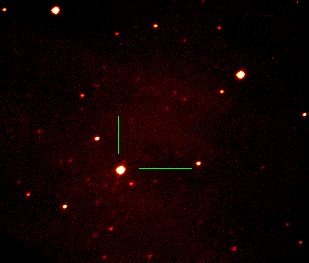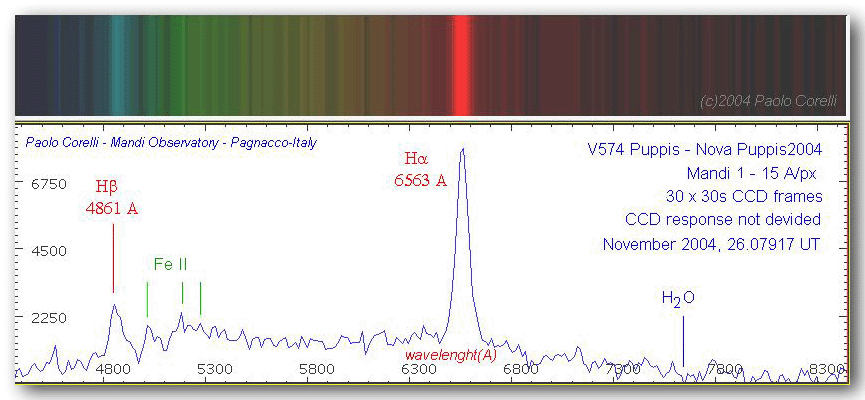 |
26/11/2004 00:04:45 T.U. |
Immagini di Paolo CORELLI |
Riprese da Pagnacco (Ud) |
Sezione Deep Sky |
 | ||||
| NOVA PUPPIS 2004 (V574 PUP) | ||||
| Scoperta il 20 novembre 2004 | ||||
| Ascensione retta: 07h 41m 53.76s; declinazione: -27° 06' 36.9" (J2000.0) | ||||
| Magnitudine 22.093 novembre 2004: 7.62 | ||||
| Separazione da Markeb/Markab (TYC 6547 2627): 00° 44'.5; angolo di posizione: 115°,7 | ||||
Stavolta l'immagine fu ottenuta dall'astrofilo friulano Paolo Corelli, proprietario del Mandi Observatory di Pagnacco (Ud),
una persona che conosciamo bene in quanto Paolo è il coordinatore del gruppo degli astrofili Alpe-Adria del quale anche il Circolo
Astrofili Talmassons fa parte. La nova, scoperta dai giapponesi Akihiko Tago e Yukio Sakurai nella costellazione
della Poppa (Puppis-PUP), al momento della scoperta si presentava relativamente brillante (approssimativamente di magnitudine 7.5).  Per quanto riguarda l'immagine della stella, Corelli l'ha ripresa per cinque volte ognuna per venti secondi, componendo i singoli frames nell'immagine qui sopra. Da questa ha ricavato il suo spettro che potete guardare qui sotto. 
L'analisi dello spettro ottenuto da Paolo Corelli ci mostra una stella che ha una forte riga rossa, la principale dell'idrogeno
della serie di Balmer e conosciuta come H  Di seguito riporto il messaggio che ha segnalato la scoperta, mentre sotto c'é quello dell'AAVSO.
Observers are encouraged to monitor this object in the constellation of Puppis that is currently of magnitude +7. For an astronomer in the centre of the British Isles the nova transits about 03:30 UT at an altitude of about 9°. To give scale to the accompanying diagram, the nova lies approximately 17° southeast of Sirius. Discovered (Independently) by: Akihiko Tago, Tsuyama, Okayama-ken, Japan, and Yukio Sakurai, Mito, Ibaragi-ken, Japan (IAU Circular 8443). Discovery Magnitude: +7.6 photographic (Tago), and +7.4 CCD (Sakurai) (IAU Circular 8443).
Position: Discovery Date: The object appears on two T-Max 400 films taken with a Pentax 67 camera taken November 20.672 UT (Tago), and on two CCD frames taken on November 20.812 UT using a Fuji 'Fine Pix S2' camera and a Nikon 180-mm f/2.8 lens (Sakurai) (IAU Circular 8443).
Spectra: K. Ayani, Bisei Astronomical Observatory (BAO), reports that low-dispersion spectra (range 463-690 nm; resolution 0.54 nm at
H An AAVSO chart is available by clicking here. Report Object to the AAVSO as: 0737-26 N Pup 04
Notes (from IAU Circular 8443): Congratulations to Akihiko and Yukio on their independent discoveries! 
25 Birch Street, Cambridge, MA 02138 USA INTERNET: aavso@aavso.org Tel. 617-354-0484 Fax 617-354-0665 AAVSO ALERT NOTICE 279 (January 2, 2001) 0733-25 N? PUP 2000 - POSSIBLE NOVA IN PUPPIS We have been informed by the Central Bureau for Astronomical Telegrams (IAUCircular 7552, December 30), and we announced in AAVSO News Flash No. 717, that T. Kato, Kyoto University, Japan, reports that Kazuyoshi Kanatsu, Matsue, Shimane, Japan, photographically discovered a possible nova in Puppis on December 22.731 UT at photographic magnitude 8.7, using T-Max 400 film. According to Kanatsu, nothing is seen at the location of the object on the Digitized Sky Survey, or down to magnitude 11.7 on a T-Max image taken by himself on Jan. 15.72 UT. The object is located at:
K. Takamizawa, Saku-machi, Nagano, Japan, who found the object at photographic magnitude 8.6 on Nov. 28.703 UT and 8.8 on Dec. 22.578 UT on T-Max film, reports that nothing was present at the location of the object down to photographic magnitude 14 on his 22 T-Max exposures taken between 1994 Mar. 14 and 1999 Dec. 3. Takamizawa also notes the presence of a magnitude 14.5 close stellar companion, listed in the USNO A2.0 catalogue at red magnitude 13.6 and position end figures 58.43s, 46.8". (IAU Circular 7552)
Observations of N? Pup 00 reported to the AAVSO include: Accompanying are AAVSO preliminary 'b' and 'd' scale charts of N? Pup 00 prepared by C. Scovil and K. Malatesta, AAVSO Headquarters. Please use them to observe the nova, and report your observations to AAVSO Headquarters, making sure to indicate which comparison stars you used. Congratulations to Kazuyoshi Kanatsu on his discovery!  L'immagine della stella è di 309 x 263 pixel, a 16,8 milioni di colori, ha una dimensione di 476,7 KB, qui compressi a 11 KB. La risoluzione dell'immagine è di 2.4"/pixel. Il campo ripreso è di 14,4' x 11.5'. | ||||
| Telescopio Riflettore: 200 mm di diametro; f/10 | ||||
| CCD: MX916 starlight | ||||
| Tempo d'integrazione: somma di 5 pose da 20 secondi | ||||
Homepage Per contattarci clicca: Circolo Astrofili Talmassons Copyright © 2004 di Lucio Furlanetto (testo) e Paolo Corelli (immagini), eccetto che per le circolari  Pagina caricata in rete: 5 dicembre 1999; ultimo aggiornamento (5°): 30 novembre 2004 | ||||
 a 6563 Å), una meno alta nel blu (la
H
a 6563 Å), una meno alta nel blu (la
H a 4864 Å) e tre righe verdi del Ferro ionizzato una volta (Fe II) fra i 4700 e 5300 Å:
tutte queste righe sono in emissione. C'è pure una riga in assorbimento, quella dell'acqua (H2O) nel rosso lontano a circa
7650 Å. Lo spettro fu ottenuto sommando trenta pose da mezzo minuto ciascuna, con una dispersione di 15 Å/pixel e una risoluzione di 180.
Lo spettrografo autocostruito, che l'autore ha battezzato Mandi 1, ha un reticolo per trasparenza di 300 linee/mm e i
a 4864 Å) e tre righe verdi del Ferro ionizzato una volta (Fe II) fra i 4700 e 5300 Å:
tutte queste righe sono in emissione. C'è pure una riga in assorbimento, quella dell'acqua (H2O) nel rosso lontano a circa
7650 Å. Lo spettro fu ottenuto sommando trenta pose da mezzo minuto ciascuna, con una dispersione di 15 Å/pixel e una risoluzione di 180.
Lo spettrografo autocostruito, che l'autore ha battezzato Mandi 1, ha un reticolo per trasparenza di 300 linee/mm e i